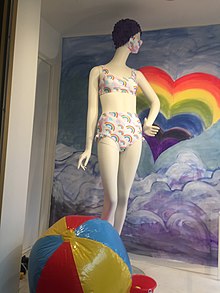Impact of the COVID-19 pandemic on the fashion industry
[3] In the first months following the start of the global lock-down, the fashion sector was shaken by the sudden stop of all retail stores sales worldwide.
The supply chain froze for a few weeks in some countries, which materialized by a lack of fabric availability and order cancellations.
[4] Domenico de Sole, chairman of Tom Ford International, remarked that "I have seen a lot of difficult situations in my long career and this has been the most devastating event, not just for fashion and luxury, but all industries."
In early April 2020, Forrester published a report predicting a $2.1 trillion loss in sales for the global retail industry in 2020.
[5] The economic crisis hit the larger department stores first: J.Crew, Neiman Marcus, Brooks Brothers and JCPenney all filed for bankruptcy within the months following the coronavirus outbreak.
On the other end, the outbreak was also the start of booming online sales for some smaller, low-overhead clothing companies that foster a close relationship with their customers.
[6] As retail stores shut their doors and stay-at-home orders kept people inside, there was a dramatic shift towards digital commerce that is likely to continue post-pandemic.
Consumers had to increase their use of services like social commerce and curbside pickup and retailers had to offer digital solutions in order to survive.
[13] According to the Harvard Business Review (2021), the covid crisis led to a great decline in traditional advertising spending, and a historic ROI from social media, leading fashion companies and brands to boost their online and digital presence.
[15] "The global trade union which works to give workers around the world a voice, says that millions of garment makers have already lost their jobs as a result of the virus and have no access to social or financial safety nets to help them weather this storm.
[16] Suppliers, though, need to pay upfront the cost of materials and fibers used to make the products they have been asked to produce from brands.
Ermenegildo Zegna coined the word phygital to describe "physical space and digital technologies" as its new way of showcasing fashion.
[21][22][23][24] More broadly they have appeared on the catwalk as a part of the haute couture's industry turn towards a utilitarian flair,[25][26] and furthermore with the global rollout of effective vaccines thought is now being given to "the post-COVID look".



